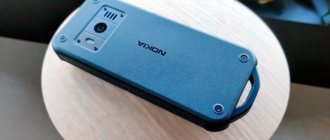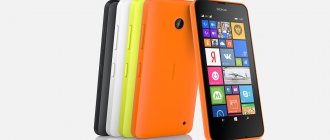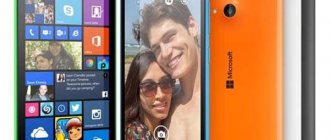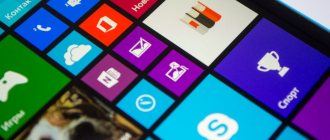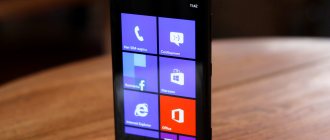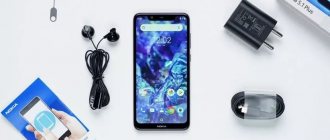Today, many have begun to forget about Windows Phone and smartphones developed jointly by two giants: Nokia and Microsoft. The phones did not find great popularity and did not win the love of the public, but this does not say anything about their quality. Authentic and original Lumiya smartphones are definitely worth your attention, and perhaps one of them will be your next phone.
In this review we will talk about one of the most significant flagships among devices running on mobile Windows - Nokia Lumia 920. Characteristics of the gadget, a description of the main technical aspects, and reviews from users are presented below.
Introduction
Despite the fact that Windows Phone 8 is a morally outdated platform, among the gadgets running on its basis there are emeralds that are worthy of attention even today. One of these devices is the Nokia Lumia 920, the technical characteristics of which still inspire respect to this day. This model is the flagship of the series, which includes all the best that Nokia has achieved during the period of working in tandem with Microsoft. Unlike other representatives of the line, the 920th model has virtually no compromise solutions; every element of the device is the best that existed at the time the smartphone was released. At the same time, the phone costs several times less than its main competitors, which makes it stand out against their background. The bottom line is that an ideal gadget based on Windows Phone 8 emerges, which is the Nokia Lumia 920 smartphone. Characteristics, reviews, reviews from professionals - everyone unanimously predicts the phone to be the best.
Nokia Lumia 920 :: Review :: Conclusions
In general, the conclusions will not be original - in many ways they copy what I wrote, say, in a review of the Lumia 800 on the previous version of the operating system. Windows Phone is a very successful platform, pleasing with its speed and well-thought-out interface. In version 8, it received many necessary improvements, perhaps the most important of which is direct file transfer via USB without the need for “crutches” in the form of the Zune manager.
The Lumia 920 looks great compared to the flagships of other manufacturers, in no way inferior to them in terms of standard characteristics and workmanship, and looks advantageous due to unusual functions and properties, such as an interesting camera, wireless charging, and a display with smooth edges.
Among the disadvantages, it is worth noting some shortcomings that are more characteristic of the Windows Phone infrastructure than the device itself - for example, the selection of powerful games in the Store is still limited. Well, for 25,000 rubles (the average price of the Lumia 920 on YandexMarket at the time of writing the review), it would clearly be worth adding wireless charging to the package – even the simplest one! This would be the right step in terms of attention to the consumer, and a marketing decision justified by common sense, which would make it possible to more clearly promote the innovative function.
Case design and materials
Dimensions: 130 by 71 by 11 millimeters. Weight: 185 grams.
The 920 model uses the now classic “sandwich” case. The main part of the body (almost all the details are concentrated in it) is a bright plastic block. On top of the plastic box there is a glass platform with a display. The smartphone uses fairly tough and high-quality polycarbonate. There are several bright colors: yellow, gray, white, black, red. Some of the colors are matte, the other part are glossy (the former are much more practical, since minor damage is more difficult to notice on them). The case looks interesting and elegant, but such a sophisticated design has a bad effect on the weight and overall dimensions. However, Nokia users know that their gadgets are the heaviest in the category.
Housing, controls
There are no special changes here, everything is in the style of the latest new products from Nokia. The case is non-separable; you cannot remove the cover and replace the battery. Most of the front panel is occupied by the display, under which there are standard Windows Phone navigation buttons: a “Back” button to return to the previous screen; the Win (home) button, which returns to the start screen and the search button. On the back panel there is a camera eye and the main speaker. At the top of the case there is a standard 3.5 mm input for headphones and a microphone. At the bottom there is a MicroUSB port for charging and data synchronization. The left side is almost empty, not counting the SIM card slot (opened with a special paper clip). Along the right side are the standard Lumiya control keys: a volume rocker, a lock button, and a camera shutter.
Nokia Lumia 920 :: Review :: Performance and Power
The device heats up significantly during operation, especially when using applications that involve the camera. When the video player is operating, the heating is very moderate.
How efficient is the Lumia 920 in using its battery? We charge the battery to 100%, reboot the device to clear the memory of clogging programs, turn off all wireless interfaces except cellular communications, and set the screen brightness and volume to maximum. We launch a movie in MP4 format, lasting 1 hour 23 minutes and weighing 1.45 GB. After finishing the movie, we look at the remaining battery charge: Energy efficiency is at the level of good “androids”, and provides two days of work. But still far from the record - for comparison:
Model - Battery - Remaining percentage Nokia Lumia 920 - 2000 mAh - 80% Nokia Lumia 900 - 1830 mAh - 83% Samsung Galaxy S III - 2100 mAh - 87%
The “performance and power” section also includes such an interesting accessory available for the Lumia 920 as wireless charging. An inductive coupling receiving antenna is integrated into the phone, and a similar one is located in the charger, which can have a very different appearance - both in the form of a small panel connected to a regular network adapter, and in the form of a glamorous pad, and built into various external gadgets - for example, wireless acoustics.
The only thing that is not clear is why wireless charging (the simplest one) is not included in the package?! Real nonsense at a phone price of 25,000 rubles - after all, the elementary filling of this charger does not imply its cost of more than 3-5 dollars...
Display
One of the main criticisms of Windows Phone before the release of the eighth iteration was the lack of support for HD resolution. The picture always looked bad, individual pixels could easily be seen, and the overall graininess of the image killed the smartphone experience. The new operating system gave birth to a new generation of devices. Devices with HD displays.
Nokia Lumia 920 is equipped with a 4.5-inch display with a resolution of 1280 by 720 pixels (PPI value - 332 ppi). In fact, gadget owners have one of the best displays in the history of smartphones. There are a number of advantages that make the 920's screen stand out from its competitors. For example, a chic IPS matrix, pleasing with rich, realistic color reproduction and the absence of AMOLED disadvantages in the form of pixelation. The presence of a proprietary ClearBlack polarizing layer, thanks to which the black color on a smartphone really looks like black, without unnecessary tints and grayness. This technology also allows you to use your smartphone in direct sunlight without any problems. Among other things, this particular model uses Pure Motion technology, which should supposedly eliminate “blurring” when scrolling through web pages and lists. Well, the icing on the cake is an ultra-sensitive display that can recognize the touch of various physical objects, including a stylus and long nails (which girls will certainly like). Works well with gloves in the cold.
Nokia Lumia 920 :: Review :: Display
The screen glass has curved edges - just like the Nokia N9 had at one time. An interesting and convenient design solution - in the N9 it was dictated by a “buttonless” system and all manipulations were based on a sliding horizontal movement of the finger across the screen, and in the Lumia 920 the smoothness simply adds to the pleasure of handling the device
The Lumia 920 has an extremely high pixel density per inch: 332. For comparison, the Galaxy S3 – 306, iPhone 5 – 326. The IPS matrix provides impeccable viewing angles and high-quality black color (thanks to the “hardware” polarizing layer and software processing), although , of course, and not as deep as AMOLED screens.
Another important feature of the 920's display is sensitivity to gloved fingers. Also, the screen can be successfully operated with long nails, using metal keys, etc. This function is turned on in a special settings menu and, frankly, it is reasonable to keep it turned on all the time - high sensitivity does not cause any discomfort when working with bare fingers, and there is no point in switching back and forth...
CPU
When it comes to devices such as the Nokia Lumia 920, the technical characteristics of the performance part fade into the background, since most often they do not matter. Thanks to the meticulous work of Microsoft programmers, mobile Windows works great on any hardware. The 920th model operates on a chipset from Qualcomm – Snapdragon fourth series. Adreno 225 is responsible for graphics. When developing the chipset, a 28-nanometer process technology was used, which made the chip more energy-intensive, economical and at the same time faster.
The processor allows you to run complex programs and top video games with an abundance of 3D graphics on your smartphone. Bundled office applications also perform well, such as the massive text editor Microsoft Word or another component such as Excel, which requires high performance to work with large tables. When testing all the games released at the time of the smartphone’s launch, the gadget produced the maximum number of frames per second and crushed all competitors from the Android camp.
Nokia Lumia 920 :: Review :: Kids mode
Do you remember the old joke about how a programmer had a heart attack when his young son called him from home at work and asked: “Dad, what is “Format C:\complete”?
So, “Children's mode” is one of the most interesting features of the device, which will obviously appeal to parents whose children regularly beg for a mobile phone in order to play, and return it with the words “sorry, I deleted something there and moved it by accident...” And What can we say about the risk of manipulation in the menu, which returns the device to its boxed state, with the loss of all files and programs?!
Now you don’t have to worry about this - a special children’s mode completely changes the appearance of the phone’s interface, allowing your child to access only those programs and files on the phone that you previously open for him!
Memory
One of the main advantages of the 920 model over its younger brothers is the presence of a gigabyte of RAM (versus 512 megabytes for the main array of devices). Why is this such a big advantage? The problem is the limitations of the Windows Phone Store app store. Many complex applications and video games require at least one gigabyte of RAM on the device, otherwise these programs will not be available (the user will not even see them in the store). One gigabyte is also enough for full multitasking, applications are retained in memory for a long time, browser tabs are reloaded less often, which also saves device power.
Excellent performance also applies to the main memory; the volume of ROM in the device has reached 32 gigabytes, which in the case of a Windows Phone device is more than enough (even with a reserve). The only downside is that this volume cannot be increased using memory cards (there is no slot for microSD format arrays, which means you will have to allocate a “cloud” for storing photos and documents).
Examples of photos and videos
There are enough settings for taking photos and videos. You can adjust exposure compensation, select ISO in manual mode, or set automatic, white balance and, of course, shooting mode.
Autonomy
As mentioned above, the device has a non-removable battery with a capacity of 2000 milliampere hours. Battery life on a single charge is perhaps one of the most important indicators in any modern portable gadget. By the way, other models in the series, such as the 720, for example, showed excellent autonomy results. Unfortunately, due to the more serious hardware and HD display, this does not apply to the Nokia Lumia 920 phone. The battery life specification from the manufacturer usually promises more than a day of activity, but in reality this figure is much lower. On average, a smartphone can last a little more than 7 hours, which is generally not bad, the result is average for a hospital. With increased activity, problems with connecting to the mobile network and the operation of navigation services, the operating time is significantly reduced.
Camera
What has really always pleased us about flagship devices from Nokia, and what Lumiya’s entire PR campaign was built on, is the camera. The flagship Nokia Lumia 920 was no exception. The camera's performance is impressive. The photo lens is definitely the best in its segment. The camera uses PureView technology, which debuted in the luxurious Nokia 808. But as often happens, all that remains of the technology is the brand; the technology itself is not actually used. The 808 model featured a 41-megapixel photo module, which made it possible to combine information from several pixels. It’s impossible to do this with the 8-megapixel module in the 920, so the loud name PureView hides only a set of modern technologies and camera characteristics that can be found in other gadgets.
In addition to the 8.7 megapixel resolution, the phone boasts advanced Carl Zeiss optics, a BSI sensor, high f2/0 aperture, and optical stabilization (the first smartphone to support this technology).
As for the latter, it is because of it that the smartphone came out so plump and heavy. An optical stabilization module is installed in the body, which forces the lens to move along two axes in order to compensate for any movement on the part of the shooter. Powerful software products are also used that allow you to modify photos, process and share them on social networks. These camera features have become key for the Nokia Lumia 920 phone.
Nokia Lumia 920 :: Review :: Camera
Cameras in Nokia devices are a special pride of the company, and virtually all the latest progressive innovations in this area in relation to smartphones come from the Finns. This is the virtually iconic N8 with its huge physical matrix size, previously unheard of in phones, and the 808, with PureView technology, and now the Lumia 920, with optical stabilization unique for smartphones and aperture ratio that allows you to take high-quality pictures without a flash in such conditions in which other cameras produce only shapeless dark spots.
The aperture value of the Lumia 920 camera lens is 2. (Remember that the smaller this number, the better, since it means the amount by which the light entering through the lens onto the matrix is attenuated). Similar light sensitivity is extremely rare - the same aperture, for example, is found in the HTC One X (while the Galaxy S3 has 2.6 and the iPhone 5 has 2.4)
So, together with optical stabilization and proprietary software algorithms, the 920 demonstrates the phenomenal ability to shoot in the twilight without a flash! Someone will say - why shoot without a flash if you have one? That’s how it is, but any photographer can immediately name many situations in which a flash is completely inappropriate and unacceptable. The simplest thing is to photograph a person in a dim room where the lights cannot be turned on (for example, in a cafe, club, at a concert) or photographing an evening landscape. In both cases, when using the flash, the spot within its range will be highlighted, and the background will be completely lost. That is, in a club you will see a person without a surrounding interior, and the landscape will not work at all...
The camera interface is quite minimalistic – in the style of the general Metro concept.
Many smartphones that have electronic image stabilization when shooting video can be turned on or off as desired. Why this was done is not entirely clear, especially since whether you turn it on or not, there is little difference... But optical stabilization when shooting video (and when shooting photos too!) in the 920 does not turn off and always works. Also, when shooting video, the function of pure recording of loud sounds works - peaks of up to 140 dB are recorded, which on other smartphones usually “shut up” and overload the microphone.
A separate topic is additional photo applications. These are cool software things - from the category of those that until recently existed everywhere in the form of cloud online services, and now you can play with photos directly using the hardware resources of your smartphone. By default, the Lumia 920 has 3 photo applications installed, which can be accessed both from individual icons and from the camera menu. These are Cinemagraph, Smart Shoot and Panorama.
At the touch of a button, Cinemagraph makes fun GIF animations in which the user can highlight moving areas of their choice while leaving the rest stationary. Smart Shoot again allows you to take a series of pictures with one click, from which it forms a picture without interference - for example, a photograph of a tourist attraction that will not be obscured by random passers-by. Panorama – well, everything is clear with it from the name. Similar functions, in general, are known from various desktop programs for fun photo editing, and now they are available on smartphones. The number of camera apps will continue to grow in the future.
Operating system characteristics
The entire 2012 Lumiya line runs on the same operating system. The Nokia Lumia 920 has no software advantages over younger models. But there are a lot of advantages over the notorious Android and over other smartphones that work with Windows.
First of all, we see the same Windows Phone 8. A simple and uncomplicated system with excellent interface implementation and high-quality optimization. There are no performance problems observed in smartphones running Windows Mobile.
In addition to the classic “tiled” interface, the user will find a number of programs developed by Nokia. One of these was the music player – Nokia Music, which allows you to listen to popular playlists created by the curators of the service for free. Nokia Here navigation services also cannot be ignored. The latter were liked by CIS users, because this is the most accurate and convenient navigation service for our regions (among the free ones, of course).
One of the features of the firmware is its close integration with Windows. Precisely with Windows, and not with the disgusting Zune. Now video files and music can be downloaded to your phone in any format, and the conversion will be handled by the system. Comfortable.
Nokia Lumia 920 :: Review :: Key features
Contacts and calls
SMS
Calendar/planner/alarm clock
Calculator
Audio
The player sounds great and allows you to customize the sound very flexibly. In addition to your own MP3 content downloaded from your computer, in the Nokia Music music application you can use the MixRadio service, downloading free selections of songs with limited listening and copying capabilities, as well as buy albums and tracks (from 10 to 20 rubles per track)
Video
The player supposedly supports a slightly larger number of formats than the player in WinPhone 7 devices, but is still far from omnivorous... A test film in AVI format, which I traditionally use to compare energy efficiency (more on this below in the “Performance and Power” section) it didn’t “eat” - I had to convert it to MP4. It was also not really possible to test the player for HD video, because it doesn’t support MKV either...
Gallery
The gallery is simple, and the options for editing photos are also simple. In fact, there is only frame cropping, rotation and simple automatic color correction with one button
Browser
Extremely fast and convenient Explorer 10 - works faster and more conveniently than all mobile browsers I know
Reviews
Users' opinions about the 920 model differ. Some fell in love with the new platform at first sight and see the future in it, while others, unable to find the necessary applications, gave up and forgot Windows Phone like a bad dream.
Those who are positive about the platform appreciated the ability to download multimedia without resorting to additional tools, as was previously required.
For many, a big reason for joy was the set of Nokia Here maps with free voice navigation (many even purchased the device just for them).
As for the phone itself, the public appreciated the interesting design solutions, high-quality assembly and bright design. There were no those who were dissatisfied with the hardware platform; the vast majority appreciated the characteristics involved in the Nokia Lumia 920 device. Negative reviews mainly affected the weight and dimensions of the device, as well as the lack of necessary software. The phone is indeed weighty, despite the fact that it is slightly larger than its competitors in size. The 920 Lumiya will easily pull at your pocket and create discomfort. There are also problems with the application store, or rather, only one - unfortunately, there are no applications. Finding a modern game or an increasingly popular photo editor on mobile Windows is simply impossible.
Nokia Lumia 920 :: Review :: Navigation
In reviews of Android smartphones, I try to place GPS functions in the “Standard functions” section, because the basic pre-installed navigation from Google is no different from Google, especially since it does not have the main advantage of proper navigation - offline maps... However, Nokia navigation clearly deserves more attention and special attention section, since one of the few provides free downloading and installation of offline maps, and in general has all the necessary properties for 99 out of 100 people! Nokia navigation provides the opportunity to view maps in various variations, find any POI, and get directions on foot, by public transport or by car.
Optimists can squeal as much as they want about progress, about the widespread distribution of 3G, 4G and Wi-Fi, as well as about the constantly falling prices for mobile Internet traffic, but the first problem with any of the above is complete ignorance of the route along which you urgently need to get to the desired destination. addresses, terrifies them and sends them into the camp of the “traditionalists” - those who believe that the INTERNET SHOULD NOT BE REQUIRED for basic navigation functions to function properly.
